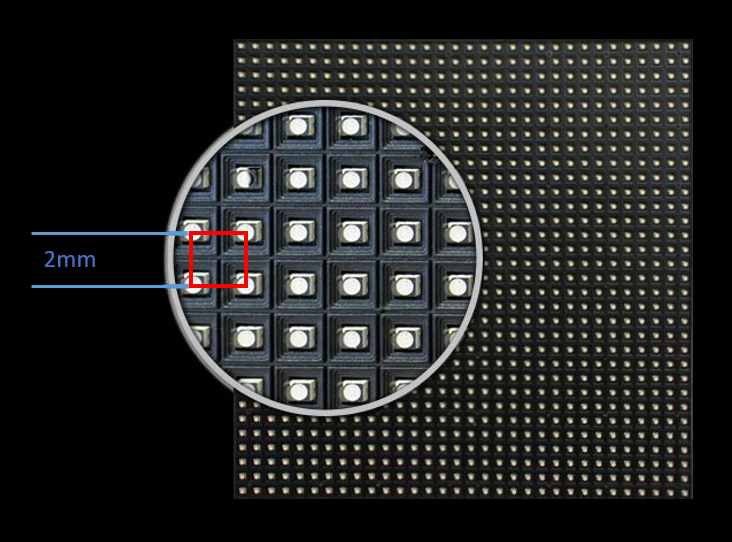Welcome to back to LED Insights, where we shed light on the world of LED displays and help you make informed decisions for your visual needs. One of the most crucial factors to consider when investing an LED display is the pixel pitch. Determining the right pixel pitch for your specific use case is essential to ensure optimal viewing experiences and avoid unnecessary expenses. In this blog post, we'll explore the significance of selecting the correct pixel pitch, particularly for fixed installation products.
Pixel pitch refers to the distance between the centres of adjacent LED pixels on a display. It is usually measured in millimetres (mm) and is a vital specification that directly influences the display's image clarity and resolution. A smaller pixel pitch translates to higher pixel density, resulting in a more detailed and vibrant image.

The rule of thumb is that the minimum viewing distance (in meters) is approximately equal to the pixel pitch (in millimetres). So, for a 2mm pixel pitch screen, the minimum viewing distance would be around 2 meters.
As a simple rule, minimum optimum viewing distance is calculated using the display's width or height. For example, a 10m wide screen should be viewed from at least 10m back for the eye to take in all the onscreen information. Of course there are exceptions to this rule.
When choosing the appropriate pixel pitch for your LED display, it's crucial to consider the specific use case and the content you wish to display, and crucially who is it for? Different applications have distinct viewing distances and requirements, which directly affect the optimal pixel pitch.
Consider the type of content you intend to display. Just because a screen is being installed with the option for viewers to get close, the content may simply need to be large, bold, and colourful, so a tight pixel pitch may not be necessary. However, if the use case of that screen were to change, or if fine text or high-fidelity imagery is occasionally needed, you must accommodate for this! Once you've determined a pixel pitch, there's no going back... Unless, of course, you've specified the EDGE range, where you can upgrade pixel pitches whenever you wish!
One common mistake in LED display installations is failing to cater to the closest target audience. The pixel pitch chosen should be based on the distance of the nearest person you wish to view the screen. If the pixel pitch is too large for the closest viewer, the image will appear pixelated and lacking in detail. On the other hand, if the pixel pitch is unnecessarily small for the viewing distance, it could lead to a waste of resources, as a higher pixel density would not be effectively utilised.
We follow this rule "What do you want to see, and where do you want to see it from"
Example 1: Shop Window Digital Signage: Considering an LED display for your shopfront window? Identifying your primary target audience is crucial. Is it pedestrians directly outside your window? A narrow pixel pitch might be necessary. Or is it viewers from 100m away? Then, a wider pixel pitch could be more appropriate. If you're aiming to capture both groups, prioritise the needs of the nearest viewers for effective advertising.
Example 2: Corporate Lobby Displays: When a client seeks to install a vibrant, eye-catching display in their main lobby for straightforward "bold" messaging and digital signage without detailed text, there's little benefit in opting for anything below P1.8. In many cases, P2.5 will suffice. However, future changes in how the screen is used could pose challenges with this pixel pitch. It's vital to explore all potential applications with your client before finalising your choice, and make them aware of any limitations a choice may cause.
Example 3: Lecture Theatre Display Solutions: If your client's lecture theatre features seating that begins 8 metres from the screen, and content will always be displayed in a 16:9 aspect ratio, a tailored approach to resolution is advisable. Opting for a standard 1080p resolution might seem the straightforward choice, yet exploring a custom resolution that maintains a 16:9 aspect while utilising scaling can efficiently meet requirements and save money. To offer cost-effective solutions without compromising quality, starting with a P2.5 pixel pitch is worth exploring, given the audience's minimum distance of 8 metres from the screen. This strategy ensures clarity and visibility, aligning perfectly with spatial and financial considerations.
Choosing the wrong pixel pitch can have financial repercussions. Opting for a pixel pitch that is too small for the intended use case might result in higher costs without delivering noticeable benefits in image quality. On the contrary, selecting a pixel pitch that is too large for the viewing distance may lead to a subpar display experience and, eventually, higher expenses to rectify the situation.
Remember, the higher the display resolution, the higher the content resolution should be. This also affects content creation costs, and as a result, content playback devices become more expensive. All of these factors provide even more reason to carefully consider all available options!
Selecting the right pixel pitch for your LED display is a vital decision that directly impacts the quality and cost-effectiveness of your visual investment. Considering the specific use case and catering to the closest viewer's distance are essential steps in making an informed choice. With the proper pixel pitch, your LED display will deliver stunning visuals that leave a lasting impression on your audience while optimising your investment.
At LED Studio, we understand the significance of choosing the right pixel pitch for your unique requirements. Our expert team is here to assist you in finding the perfect LED display solution tailored to your needs. Feel free to reach out to us for any inquiries or personalised assistance.